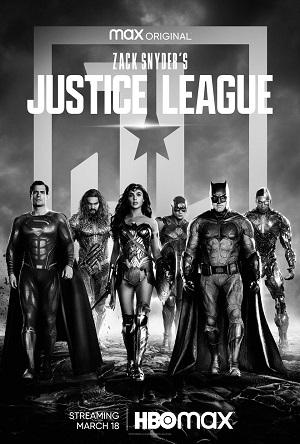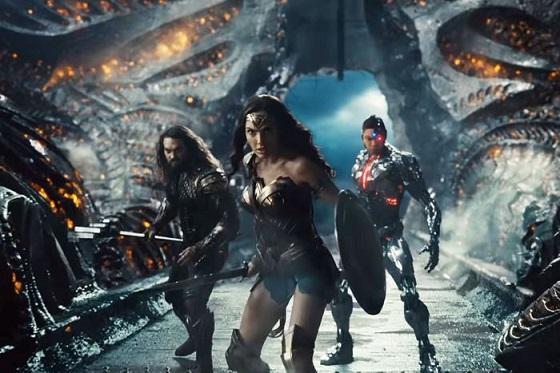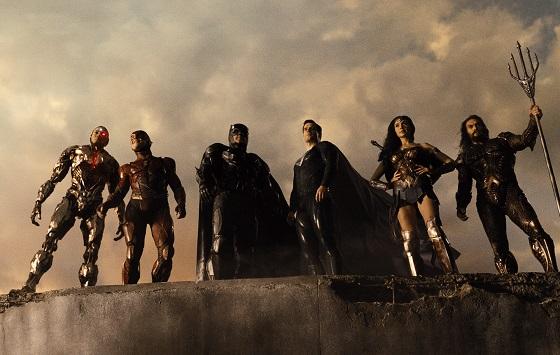

[Rating: Minor Rock Fist Down]
Now streaming on HBO Max
How did it come to this? Justice League already came out in 2017, sucked, and was all set to drift into cinema’s great, forgotten ether when a legion of delusional stans demanded something that didn’t exist: “The Snyder Cut.” Director Zack Snyder famously departed the project early in production after a devastating family tragedy, leaving the completion of the film to Joss Whedon, two-time director of Marvel’s Avengers series, yet the broad consensus was that the 2017 film was a mess from top to bottom, and no amount of re-jiggering in the editing suite could have prevented that. Zack Snyder’s Justice League (2021) confirms this hypothesis and then some, for even with reshoots, an extra two hours, and a mulligan budget rumored to be in the $80 million dollar range, this film is undeniably, irredeemably awful.
The basic thru-line of the plot often gets lost in character introductions (and re-introductions) that would have been better suited to stand-alone origin story films, but the essence of it follows Batman (Ben Affleck) trying to get a super squad together to help protect the planet now that Superman (Henry Cavill) is dead. Batman v Superman: Dawn of Justice established that “metahumans” like Wonder Woman (Gal Gadot), the Flash (Ezra Miller), Cyborg (Ray Fisher), and Aquaman (Jason Momoa) are out in the world, so now that the planet is without its favorite Kryptonian, Batman is determined to get the B-Team up and running.
Superman’s death in Dawn of Justice also kicked off a different search, this one by an intergalactic henchman named Steppenwolf (Ciarán Hinds), who is trying to win over his middle management boss, DeSaad (Peter Guinness), in the hopes that he’ll return to the favor of the REAL bad guy of the film: Darkseid (Ray Porter). To do this, Steppenwolf has to collect three MacGuffins called “Mother Boxes,” which will supposedly destroy the planet once they’re combined and synced up (or something…they are combined at one point but nothing happens). As Steppenwolf easily whips ass in his pursuit of the boxes, the heroes must come together (which they were already sort of doing anyway) to stop this catastrophic threat.
One of the criticisms of 2017’s Justice League was that the story didn’t make a lot of sense, and outside of the broad strokes, the narrative was a jumbled mess of half-ideas and rushed character work. To the new film’s credit, many of these practical wrinkles are ironed out, including some much-needed backstory for Cyborg and Flash, and an expanded flashback sequence that connects the Mother Box history to Steppenwolf’s mission as a disciple of Darkseid. These narrative efforts, successful as they are in some cases, merely act as a cast for a broken bone on a body that is riddled with cancer, however.

Justice League, in any version, is fundamentally flawed, as it relies on pure spectacle and the existing good will towards characters within a rushed franchise that hasn’t had time to set up most of them. The movie has to spend time introducing the audience to Cyborg, Flash, Aquaman, and Steppenwolf, robbing it of any juice the promised team-up provides. This movie should be the culmination of several independent stories from both the good guys and the bad, all coming together to tell a new story using emotional currency built up over time. Even with two extra hours to blow the story out and introduce its leads, this film never has a chance to reach a point where its very conceit (the members of the Justice League coming together) is rewarded.
When Martin Scorsese penned his op-ed in the New York Times in 2019, he bemoaned a cinematic landscape that has transformed into a feast-or-famine proposition whereby smaller, intimate stories don’t have the oxygen to breathe inside a movie ecosystem that prioritizes resources for superheroes. If he’d stopped there, his opinion might have become something other than a punching bag for countless Reddit, Twitter, and Facebook posts, but the legendary director doubled down, saying that all these movies about iron, spider, super, or aqua men also lacked “revelation, mystery, or genuine emotional danger.” Many of those who watched Robert Downey, Jr., Chris Evans, and Chris Hemsworth mature and develop over the course of 20+ films would likely take issue with Mr. Scorsese’s latter point, though if a person were to just look at the D.C. Universe’s output, this new Justice League in particular, Scorsese starts making more and more sense. It’s hard enough getting movies made these days and will become harder still when superhero movies start getting second chances to right their own wrongs.
D.C. has never managed to successfully build the interconnected comic universe that propelled each new Marvel film into record-holder status at the box office, and the ones that had that potential (the Christopher Nolan trilogy) never got to germinate within a larger franchise petri dish. And while Marvel hardly has a perfect track record (cough, cough…Thor 2) the universe had four years to expand on the layers each new film added to the overall texture before cashing in that audience credit for a grand meet-up event. The DECU had just four films out in the world before they took their first stab at Justice League in 2017, and two of those were cross-over flicks that didn’t independently establish the Justice League leads. Marvel had two Iron Man movies, and Hulk, Thor, and Captain America stand-alone films before teaming them up in Avengers (that film’s bad guy had also been introduced by that point), and the subsequent years only further built up these characters and the interconnected drama each film provided.
In the four years between Man of Steel and 2017’s Justice League, there was no Flash or Aquaman movie, and nothing to establish Steppenwolf or Darkseid as the big bads for these characters. The Synder Cut benefits from the intervening exposition afforded by 2018’s Aquaman and last year’s Wonder Woman 1984, but even these additions do little to give this new version much in the way of heart or buy-in, feeling instead like Scorsese’s empty vessel devoid of emotional danger. Sure, Cyborg’s backstory makes more sense in Zack Snyder’s Justice League, even if his irrational hatred of his dad is a little weak sauce as far as character motivation goes. Likewise, Flash gets some nice world building with the job interview scene and the extra time with his dad (Billy Crudup), yet he’s little more than a prop in service to the action.

There’s nothing in the film that binds him or any of the other members of the Justice League together, whether it’s tension, rivalry, or admiration. About the best the flick can manage in this regard is everyone having some level of a crush on Wonder Woman: a real kick in the pants for a film with just a handful of female speaking roles. Additionally, the audience doesn’t really know the bad guy before some painfully dull exposition dialogue lays out his entire agenda, and even with the additional character work, nothing about this team-up of heroes feels interesting or compelling with Steppenwolf and Darkseid on the other side of things.
Making matters worse, the action set-pieces aren’t shot particularly well, and don’t have a defined sense of space or place, seen most pointedly in the climax with whatever the hell Flash is doing. The extra time afforded to the characters doesn’t develop them to the point where there’s audience investment in the meet-up that defines the film’s very existence, and not to put too fine a point on it, but this monstrosity is just too damn long at 242 minutes. What little benefit was gained by beefing up the characters is eliminated by additional scenes that slow the pacing and muddy the narrative waters.
There are some improvements over the original, sure, like a plot that actually makes some amount of sense, and character work that gives the appearance of Flash, Aquaman, and Cyborg a somewhat reasonable sheen. The new score by Junky XL offers the film a grittier, more textured base that feels more of a piece with the material than Danny Elfman’s 2017 version, and any time Ezra Miller is on-screen (which Snyder beefed up in this new version), the film has a buoyancy that elevates the material. There’s a version of this film that has a few re-shoots and added character moments that shore up the plot deficiencies and streamlines the narrative, but this new Snyder Cut isn’t it. This movie didn’t need a second Aquaman introduction any more than it required the final 20 minutes that set up sequels Warner Brothers has no intention of making, and it’s these extraneous moments that bring the larger effort’s batting average back down.
No bother, though: not for Zack Snyder. If the drama surrounding this new Justice League has taught the director (or the world) anything, it is that a movie doesn’t have to make sense, be entertaining, or serve an emotional end. No, it just has to rile up the fanboys enough with a handful of interesting, half-baked ideas to get something made that has little reason to exist in the first place.





Comments on this entry are closed.